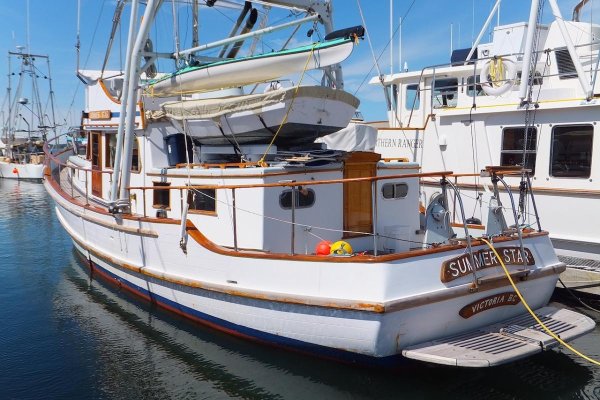Hi, Capt Dave owner of Swan Song here.
Swan Song started its life as a full displacement single screw Trawler. Sold as a North Sea 58 model back in 1975.
Owned by several folks who I suspect had great dreams about passage making but could never find the time to go very far. We bought it in 1998 in the British Virgin Islands. She had great bones: 2 1/2 " hull thickness tapering to 5/8" at the rails. It was built on the Taiwanese Offshore tuna fishing boat. Ed Monk Sr was hired to make the hull/deck into a suitable pilothouse trawler.
After a 5 year total refit she actually became suitable for crossing oceans.
Single DD 6-71 165 HP @ 1925 max rpm. Dry stack exhaust
38 X 28 3 bladed prop located behind the keel with a rudder supported by the keel extension.
Full displacement with 20,000 lbs of 3500/yd concrete. We weigh in at 104,000 loaded for a long passage.
10 KW genset, full air conditioning, 5 KW alternator driven by 2 kevlar belts.
Full nav gear both 'old school' aka SSB, etc to State of the Art gear like a fully redundant Fly by Wire engine operation and autopilot. No wheel or hydraulics in the Pilothouse. An Anti Roll Tank, ART which blows everyone's mind when the join us for an offshore passage, Totally passive and uses no power. Works underway or at anchor
We've stayed off a dock/land for as much as 60 days as she's self contained with fuel/stores/ water/ice cream.
Recently we made the run back from Honolulu, 2800 NM to long Beach. We had to drive around a bit to avoid so nasty weather but still ended up going thru 3 gales, 20+ ft seas and winds in the 35-50 knt ranges.
The down to the Panama Canal, up to Jamaica, over to Isla Mujeres and on to Ft Myers, Fl. a little over 8000 nm. Averaged 3.2 NM/gal! Damn efficient for a 50 ton boat!
Weather forecasting is still limited in anything over 10 days, IMHO, so long passages require a vessel that can stand up to the seas. We had several waves over the top and Swan Song just shoulders them off and keeps going at 2-3 kts.
SS's engine room has 6' 2" of headroom and you can walk around the engine with full engine room illumination. The slightest issue is easily seen plus we use and IR gun to shoot the manifold , belts and water. Hard to have something go astray with that level of visibility. Oh and we do it every hour!
We also shut it down at high noon everyday to check the transmission oil and diesel usage. We have a 300 gal 'day' tank....good for 4 days min....All fuel is polished when we refuel then its polished by a Gulf Coast filter as it get transferred to the 'day tank". Then its filtered from there thru a 10 micron Racor 1000 and lastly the DD on engine filter.
Little likelihood that she'd ever shut down from bad fuel ;-)
I'll stop here but just want to advise that the ocean is a place of it's own and you are but a speck on it. As an old delivery captain I've run hundreds of boats north and south and east and west with a few diagonal runs.
If you want get out offshore and make passages go see if you crew on a few deliveries. I used to always take along 1 crew who had a dream about sailing or powering around the planet. That's the way I got into this 40 years ago.
Less that 25% of the people ever wanted to get back on a boat offshore again!!
So this thread has lots of folks with tons of experience the needs to be understood and assimilated deep inside. Towboat won't come to get you nor will the Coast Guard. Once we left Hilo, Hawaii we never saw another vessel or a contrail till Catalina Island broke thru the fog 18 days mate.
Lastly you need an onboard air system and be experienced in using it in a 6-10 ft sea. We got trash on our prop 5 times and had to dive to free it....this is with a prop in aperture...hate to think what a couple of props that are exposed might catch today.
Sorry this is long but its really very very short....a Hat 42 LRC isn't going to let you sleep offshore. And if you do take it don't take anyone with you.....
Cheers
Capt Dave/Nancy
Swan Song
Custom Roughwater 58 North Sea
Lying in Ft Myers, Fl



